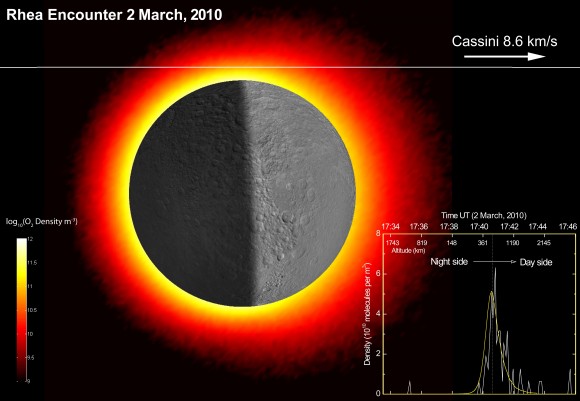The discovery was made by the Cassini spacecraft in March of this year, and the analysis was published this week in the Astrophysical Journal * Regardless, the Cassini spacecraft resumed operation after a computer failure that disabled it for several days

On March 2, 2010, the Cassini spacecraft passed near Rhea. In the picture: a simulation of the predicted oxygen density (in yellow) compared to the measurements of the INMS instrument on Cassini (in white) During the approach flight a few years ago, astronomers believed that they had discovered faint rings surrounding the moon Saturn see. Although the possibility of rings around an icy moon was later ruled out, astronomers knew that something around Ra, Saturn's second largest moon, was causing a strange, symmetrical structure of ionized particles.
Now observations have shown that something else surrounds Ra and is completely unexpected: an oxygen atmosphere. In March of this year, Cassini made a flyby and recorded data showing that the moon is surrounded by a thin atmosphere of oxygen and carbon dioxide.
The source of the oxygen is not so surprising. The density of Ra is 1.233 greater than that of liquid water, indicating that Ra contains three quarters ice and one quarter rock. The thin atmosphere is constantly maintained by chemical contraction of water ice on the Moon's surface due to radiation from Saturn's magnetosphere.
Recently, oxygen was also discovered around Jupiter's moons - Europa and Ganymede. Since oxygen is the main component of the atmosphere in the region of Saturn's rings, astronomers believe that such an atmosphere may be found around icy moons orbiting within Saturn's magnetosphere.
"The new results show that active and complex chemistry involving oxygen may be widespread in the solar system and perhaps in the universe as a whole," says the lead researcher in the article, Ben Thewlis, a member of the Cassini team of scientists and a researcher at the Southwest Research Institute in San Antonio. "Such chemistry can be a preparation for life." All the evidence from Cassini indicates that it was too cold to hold the liquid water necessary for life as we know it."
For information on the Universe Today website

Good news: the Cassini spacecraft returned to normal operations this week (November 24). NASA stated that all the scientific instruments have switched to operating mode, and the spacecraft is tuned for all its activities.
No damage appears to have been caused by a flipped bit in the control and data computer, which prevented the spacecraft from following instructions and carrying them out. Program managers expect the return of a full stream of data during Cassini's expected close flyby this week of the moon Enceladus.

5 תגובות
Rhea is the name of an Ionian goddess from the age of the Titans, the wife and sister of Kronos
Very interesting article.
To all interested parties. Meaning of the name Rhea (RHEA)
Rhea (bird
Raim (or Nando), is a family of large birds in the Poultry department, belonging, together with the ostrich,
The emu, cassowary and kiwi for the ostrich series.
A - Which moon of Saturn? It is written explicitly and more than once - lung.
Which moon exactly of Saturn?
Titan, Prometheus?